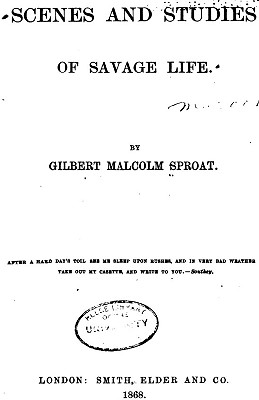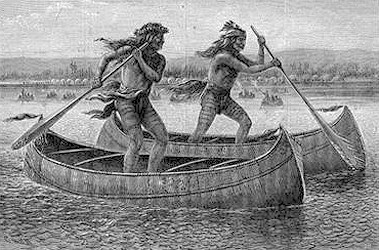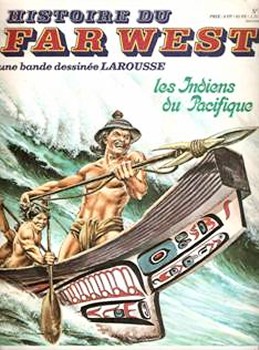
g. m. sproat : canoe riders of vancouver island, 1868
| home | catalogue | history | references | appendix |
 |
surfresearch.com.au
g. m. sproat : canoe riders of vancouver island, 1868 |
Internet Archive
http://archive.org/details/scenesandstudie01sprogoog
Herve noted:
"Sproat was businessman,
government agent, Indian reserve commissioner, magistrate, and author.
His book is an examination
of the Aht native tribe of Vancouver Island’s west coast, whom James Cook
had called Nootka."
In particular, Sproat
had a strong interest in ethnology, as evidenced by the footnote on page
85, where he makes reference to his paper published in Transactions
of the Ethnological Society in 1866.
One hundred and
fifty years before a theory of ancient coastal migration would gain some
scientific credence, Spoat does not doubt "whether savages could cross
in canoes from the Asiatic to the American shore."
For a recent compliation of scientific artcles supporting coastal migration
theory, see:
Bicho, Haws, and Davis (editors): Trekking
the Shore- Changing Coastlines and the Antiquity of Coastal Settlement
(2011).
To the south of Vancouver
Island, on 26th August 1912, the Tacoma Times reported a group of
day-vistitors traveled on the Northern Pacific Railway to Moclips Beach
in Washington where the various entertainments included "surf riding by
the Quinalt (sic) Indians."
The Quinault Indians
had developed a high degree of skill with canoes carved from cedar trees
in a variety of specialized designs adapted to
rivers, estuaries,
and the sea.
Moclips may be a
variation of the Quinault No-mo-Klopish, meaning “people of the
turbulent water.”
Also see:
1815 Peter Corney
: Hawai'i and Columbia River.
1835 Rev. Samuel
Parker : Native Canoe at
Columbia River.
1836 Washington Irving : Columbia
River Canoes.
Unfortunately, there
appears to be no accounts of the maritime skills of the native inhabitants
of California, their culture coming under severe pressure with the arrival
of Spanish missionaries in 1697.
By 1820 Spanish
influence was marked by the chain of missions occupying a 25 mile wide
coastal zone between Loreto, north to San Diego, to just north of today's
San Francisco.
-Wikipedia: History
of California to 1899, viewed 14 June 2013.
http://en.wikipedia.org/wiki/History_of_California_to_1899
"Archaeological research has shown that San Miguel Island was first
settled by humans at least 12,000 years ago, in the Millingstone Horizon
archaeological period.
Because the northern Channel Islands have not been connected to the
adjacent mainland in recent geological history, the Paleo-Indians who first
settled the island clearly had boats and other maritime technologies.
Rough seas and risky landings did not daunt the Chumash people.
They called the island Tuquan in the Chumash language, and for several
centuries, they used plank-built canoes, called tomols, to reach their
settlements."
-Wikipedia: San
Migel Island- History, viewed 14 June 2013.
http://en.wikipedia.org/wiki/San_Miguel_Island
Herve also included
the identification of Irving (1836), above, and attached two illustrations
to his post.
The first,
W. de la Montagne Cary's Indian Canoe Race, published by Harper’s
Weekly in 1874, illustrates a paddling-while-standing technique
in bark-canoes..
The second is Los
Indians de Pacifique, drawn by G. D’Antonio for the cover of a French
educative comic book, Histoire du Far West, published in 1982.
In this fanciful
represenation, a native prepares to launch his spear-harpoon while the
crew ster the canoe on a considerable wave.
Reproduced below.
During summer
they are much in the open air, lightly clad, and in winter pass most of
their time sitting round fires in a smoky atmosphere.
All the natives
swim well, but not so fast nor so lightly as Europeans; they labour more
in the water.
As divers they
cannot be beaten; a friend of mine saw Maquilla, a noted warrior and fisherman
of the Nitinahts, dive from the stern of a boat, in five fathoms of water,
and bring up a pup seal in each hand from the bottom.
On approaching
the boat, one of the seals got away, but Maquilla, throwing the other into
the boat, again dived and captured the seal before it could reach the bottom.
Till beyond middle
age many of the natives bathe every day in the sea, and in winter they
rub their bodies with oil after coming out of the water.*
[Footnote] * Throughout the year, though the climate on the whole is milder than the English climate, the water in the sea round Vancouver Island is colder than on any part of the shores of Great-Britain.
Page 36
I remember many
instances of Indians having escaped from us through their skill in swimming,
and paddling, and travelling through the woods.
The management
by a single Indian of a canoe in crossing a rapid stream cannot be surpassed.
At the same time,
I may observe that I have seen a trained crew of white men beat a crew
of Indians in a long canoe race on the sea. The civilized man seems to
have more bottom in him, when the exertion is intense and prolonged.
Page 65
The men have few out-door amusements except swimming, or trying strength by hooking little fingers, which is always conducted with good humour.*
[Footnote]* From some cause, perhaps the constant use of the paddle, their fingers are very strong ; as already stated, I have seen middle-sized natives carry heavy weights with their fingers which stalwart woodmen could scarcely lift.
Page 82 [CANOES]
Canoes are made
on this coast principally of cedar, and are well shaped, and managed with
great skill by men, women, and children.
They are moved
by a single sail or by paddles, or in ascending shallow rapid streams,
by long poles.
I have seen an
Indian boy with a single pole make good way with a small laden canoe against
a stream that ran at the rate of six miles an hour.
Canoes are of
all sizes, but of a uniform general shape, from the war-canoe of forty
feet long to the small dug-out in which children of four years old amuse
themselves.
Outriggers are
not used, but the natives sometimes tie bladders or
Page 83
seal-skin buoys
to the sides of a canoe to prevent it from upsetting in heavy weather.
The sail — of
which it is supposed, but rather vaguely, that they got the idea from Meares
some eighty years ago — * is a square mat tied at the top to a small stick
or yard crossing a mast placed close to the bow.
It is only useful
in running before the wind in smooth water.
The management
of a canoe by natives in a heavy sea is dexterous ; they seem to accommodate
themselves readily to every motion of their conveyance, and if an angry
breaker threatens to roll over the canoe, they weaken its effect quickly
by a horizontal cut with their paddles through the upper part of the breaker
when it is within a foot of the gunwale.
Their mode of
landing on a beach through a surf shows skill and coolness.
Approaching warily,
the steersman of the canoe decides when to dash for the shore; sometimes
quickly countermanding the movement, by strenuous exertion the canoe is
paddled back.
Twenty minutes
may thus pass while another chance is awaited.
At length the
time comes ; the men give a strong stroke and rise to their feet as the
canoe darts over the first roller ; now there is no returning : the second
roller is just passed when the bowpaddler leaps out and pulls the canoe
through the broken water ; but it is a question of moments : yet few accidents
happen.
The paddles
used by the Ahts are from four to five feet long, and are made of crab-apple
or yew.
Two kinds are
used ; the blade of one is shaped like a leaf, and the other tapers to
a sharp point.
The sharp-pointed
[Footnote] * Would it be fanciful to connect their first notion of a canoe sail with their observation of the membranous fan of the pine-seed, which they often see floating through the air, in the forest, after falling from the cones ?
Page 84 [MODE OF PADDLING.]
paddle is suitable
for steering, as it is easily turned under water.
It was formerly
used ag a weapon in canoe-fighting for putting out the eye — a disfigurement
which many of the old Aht natives show.
In taking a seat
in a canoe, the paddler drops on his knees at the bottom, then turns his
toes in, and sits down as it were on his heels.
The paddle is
grasped both in the middle and at the handle.
To give a stroke
and propel the canoe forward, the hand grasping the middle of the paddle
draws the blade of the paddle backwards through the water, and the hand
grasping the handle pushes the handle-end forward, and thus aids the other
hand in making each stroke of the paddle : a sort of double-action movement.
As a relief,
the paddler occasionally shifts to the handle the hand grasping the middle
of the paddle, and vice versa.
Such a position
looks awkward, but two natives can easily paddle a middle-sized canoe forty
miles on a summer day.
The Strait of
Juan de Fuca is about fifteen miles wide, and trading canoes often cross
during the summer season to the American
shore.*
The Indians paddle
best with a little wind ahead ; when it is quite calm, they often stop
to talk or look at objects in the water.
It is useless
to hurry them : they do quite as they please, and will sulk if you are
too hard upon them. In a small canoe, when manned by two paddlers,
[Footnote]* I
read with surprise the doubtful opinions of ethnological writers as to
whether savages could cross in canoes from the Asiatic to the American
shore.
The Aht natives,
and particularly the bolder Northern Indians, could do so in such canoes
as they now have without any difficulty. It is not easy to determine what
motive could induce savages to undertake such a voyage, or to migrate at
all over the sea.
The hope of reaching
a better country would not be likely to enter the mind of a savage.
He would not
move unless forced to move.
{See Paper by
G. M. Sproat in the Transactions of the Ethnological Society, 1866.)
Page 85 [MAKERS OF CANOES.]
one sits in the
stern and the other in the bow.
The middle is
the seat of honour for persons of distinction.
An Indian sitting
in the stem can propel and steer a canoe with a single paddle.
In crowded war-canoes
the natives sit two abreast.
No regular time
is kept in the stroke of the paddles unless on grand occasions, when the
canoes are formed in order, and all the paddles enter the water at once
and are worked with regularity.
The most skilful
canoe-makers among the tribes are the Nitinahts and the Klah-oh-quahts.
They make canoes
for sale to other tribes.
Many of these
canoes are of the most accurate workmanship and perfect design — so much
so that I have heard persons fond of such speculations say that the Indians
must have acquired the art of making these beautiful vessels in some earlier
civilized existence.
But it is easy
to see now, among the canoes owned by any tribe, nearly all the degrees
of progress in skilful workmanship, from the rough tree to the well-formed
canoe.
Vancouver Island
and the immediately opposite coast of the mainland of British Columbia
have always supplied the numerous tribes to the northward with canoes.
The native artificers
in these locahties have in the cedar (Thuja gigantea) a wood which
does not flourish so extensively to the north, and which is very suitable
for their purpose, as it is of large growth, durable, and easily worked.
Savages progress
so slowly in the arts, that the absence of such a wood as cedar, and the
necessity of fashioning canoes with imperfect implements from a hard wood
like oak, as the ancient people of Scotland did, might make a diflference
of many centuries in reaching a stated degree of skill in their construction.
Page 86 MODE OF MAKING CANOES.
The time for making
canoes in the rough is during the cold weather in winter, and they are
finished when the days lengthen and become warmer.
Few natives are
with-out canoes of some sort, which have been made by themselves, or been
worked for, or obtained by barter. The condition of the canoe, like an
Englishman's equipage, generally shows the circumstances of the possessor.
Selecting a good
tree not far from the water, the Indian cuts it down laboriously with an
axe, makes it of the required length, then splitting the trunk with wedges
into two pieces, he chooses the best piece for his intended canoe.
If it is winter,
the bark is stripped and the block of wood is dragged to the encampment
; but in summer it is hollowed out, though not finished, in the forest.
English or American
tools can now be easily procured by the natives.
The axe used
formerly in felling the largest tree, — which they did without the use
of fire — was made of elkhorn, and was shaped like a chisel.
Page 87
The making of
a canoe takes less time than has been supposed.
With the assistance
of another native in felling and splitting the tree, a good workman can
roughly finish a canoe of fifteen or twenty feet long in about three weeks.
Fire is not much
used here in the hollowing of canoes, but the outside is always scorched
to prevent sun-rents and damage from insects.
After the sides
are of the required thinness, the rough trunk is filled with fresh water,
which is heated by hot stones being thrown
into it, and
the canoe, thus softened by the heat, is, by means of cross-pieces of wood,
made into a shape which, on cooling, it retains.
The fashioning
is done entirely by the eye, and is surprisingly exact.
In nine cases
out of ten, a line drawn from the middle of the extremities will leave,
as nearly as possible, the same width all along on each side of the line.
To keep the canoe
in shape, light cross-pieces fastened to the inside of the gunwales are
placed
Page 88 [HOUSEHOLD UTENSILS.]
about four feet
apart, and there remain.
The gunwale is
turned outwards a little to throw off the water.
The bow and stern
pieces are made separately, and are always of one form, though the body
of the canoe varies a little in shape
according to
the capabilities of the tree and the fancy or skill of the maker.
Red is the favourite
colour for the inside of a canoe, and is made by a mixture of resin, oil,
and urine ; the outside is as black as oil and burnt wood will make it
; the bow and stern generally bear some device in red.
The natural colour
of the wood is, however, often allowed to remain.
The baling-dish
of the canoes is always of one shape — the shape of the gable-roof of a
cottage — and is well suited to its purpose.
Page 127 [COMPOUND WORDS]
We find the root
yat$ or yeU, which expresses the idea of movement of the feet or legs :
yetsook, is " to walk ; '* yetspannich, " to walk and see ; " yetshitl,
18 "to kick;'* and yetseh-yeUah (their only way of expressing either a
frequentative or plural being by
reduplication),
is " to kick frequently."
Yetseh-yet-sokleh,
undoubtedly from the same root, is a " screw steamer."
When the natives
first saw one of these vessels, noticing the disturbance of the water astern,
they attributed the propulsion to some action analogous to the stroke of
the legs of a swimmer, and so the name of "continual kicker" was at once
invented and universally received.
 |
Scenes and Studies of Savage Life Smith, Elder and Co., London,1868. Internet Archive
|
 |
W. de la Montagne Cary: Indian Canoe Race. Harper’s Weekly (1874). Right:
Cover of a French educative comic book, Histoire du Far West. Images forwarded
by
|
 |

| home | catalogue | history | references | appendix |